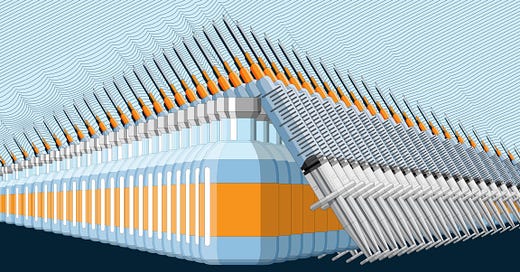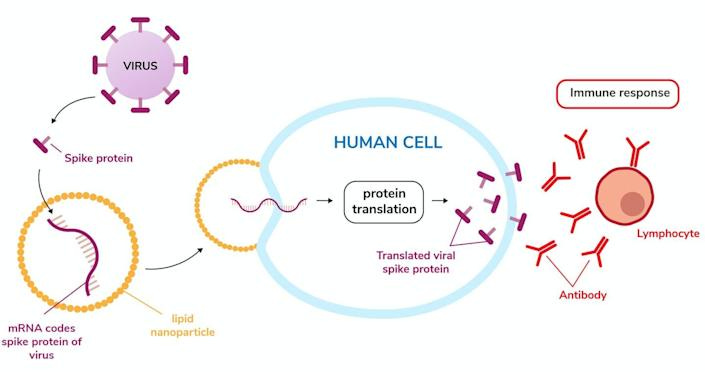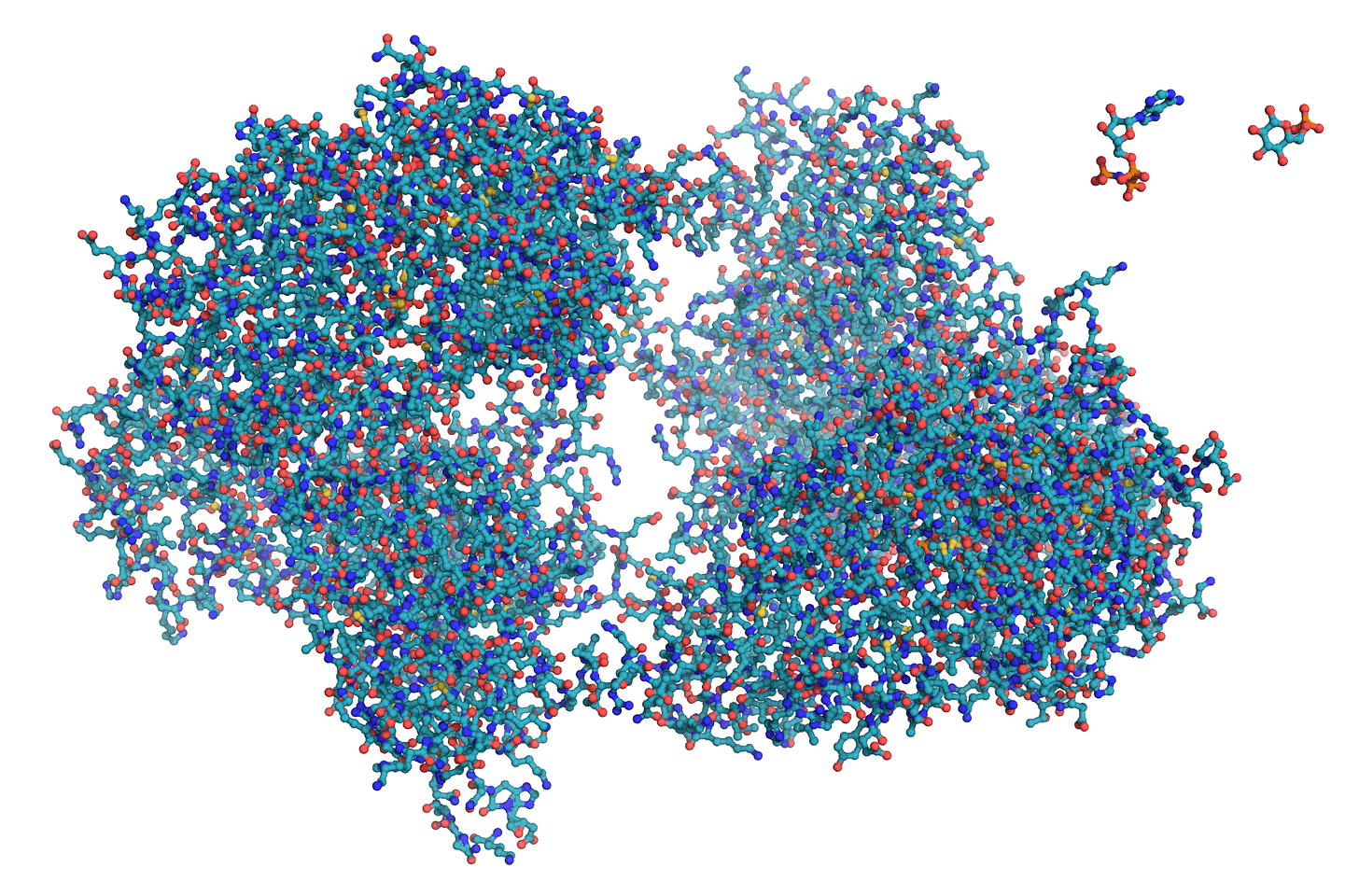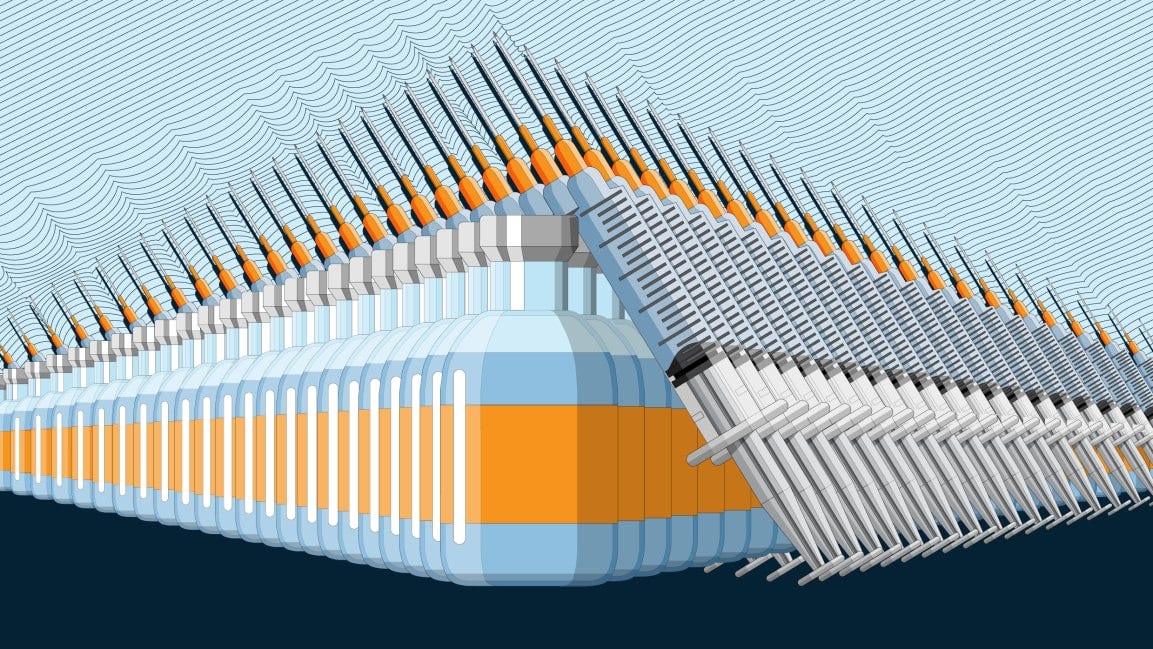The Problem: Pandemics Are Inevitable
The question of the next Pandemic is not if but when. The international travel required for a globalized economy brings concomitant increases in the global transmissibility of deadly viruses and bacteria.

This tradeoff is unavoidable in a world where lockdowns and travel bans are the only available tools to stop the spread of disease. We must either accept economic isolation or suffer through frequent outbreaks of deadly disease. However, improving technology allows us to transcend this tradeoff and have a more globalized world and better health.
The Solution: mRNA Vaccines
mRNA vaccines and our greater control over mRNA in general will prove to be the most important invention of the 21st century. Advances are happening now because the study of biology has been inextricably connected to software. Exponential growth in computing power, software tools, and machine learning have precipitated complex mathematical tools that can sequence entire genomes, predict protein folds, and synthesize any chosen string of nucleotide pairs.

It was computer powered biology that allowed Moderna to synthesize a vaccine to a virus they didn’t have isolated on site in just two days. This strategy is already proving to generalize to other diseases like malaria, AIDS and even cancer.
There is cause for celebration and despair. We had a 95% effective vaccine in January of 2020. Before the US had even ten confirmed cases on its shores, Moderna had a 95% effective vaccine. It took eleven months, millions of cases, and hundreds of thousands of deaths before this vaccine was given an emergency use authorization by the FDA, and it still not fully approved to this day. Clearly there is a massive and deadly asymmetry between our technological ability to synthesize safe and effective vaccines and our health bureaucracy’s ability to test and approve them quickly.
To understand how we can solve this problem, we need a basic understanding of how mRNA vaccines work.
Proteins are biochemical machines that perform all of the complex operations of life (and viruses!) from metabolic reactions, to the replication DNA, and the operation of the immune system. They are built out of molecules called amino acids, but as they are made the amino acids fold up and stick to each other, coalescing into extremely complex patterns. This incredible video beautifully animates the process of DNA to RNA transcription and RNA to protein translation; it goes a lot faster than you think!
The order of amino acids that make up a protein is encoded into RNA; similar to how information is encoded in binary except RNA has 4 possible states, not 2.
Due to our deep and increasing understanding of genetics and biology, we can quickly sequence the genome of pathogens and figure out what RNA code we need to produce a protein that will identify and disable the disease agent, like the spike protein on the coronavirus. Once we have this RNA code, we can feed it to protein producers in human cells, who pump the protein into the body. This protein is completely harmless while separated from the rest of the organism, but our immune system will quickly notice it and learn the appropriate response.
The Plan: An Emergency Vaccine Arsenal (EVA)
We know mRNA vaccines are safe and highly effective, and we know the monumental costs of delaying distribution too long. These facts justify spending a lot of money and modestly decreasing testing rigor in order to greatly accelerate vaccine approval and distribution in the face of the next pandemic.
The plan is to keep a rolling repository of a few thousand pre-approved, ready to deploy doses of vaccine for each of the ten most likely pathogen candidates. These might include several of the other RNA viruses like SARS or the common cold, the latest influenza virus, Ebola, and whatever else the top infectious disease experts are worried about.
We have already sequenced the genome of most the deadliest diseases so the mRNA to target these pathogens can be synthesized within days and tests for basic efficaciousness and safety could begin immediately after. The vaccines couldn’t be tested to the extreme level of rigor currently required by the FDA, but that level of cautiousness is undesirable in the face of a possible global pandemic; the FDA’s risk aversion with the covid-19 vaccine was the direct cause of hundreds of thousands of lost lives and trillions in economic damage. These vaccines would be emergency tools that are ready to deploy as soon as one of these likely candidates are detected, and would stop the spread at ground zero without the need for national lockdowns.
Since these vaccines would be pre-approved for emergency use, if a disease started to spread out of control despite early containment efforts, production and distribution of doses could be quickly scaled up without the deadly drudgery of year-long waits for bureaucratic approval.
I am clearly supportive of mRNA vaccines and the science behind them as they are a safe, effective form of protection against disease and an incredible extension of our knowledge of the micro-biological world. However, fears over giving the government the power to inject thousands of people with what they say is an essential vaccine are valid especially given the US government’s history with forced medical operations and vaccinations. It may not come as much consolation for those who fear government overreach to know that they already have the power to effectively mandate vaccinations and much more. Thinking on the margins, even if an Emergency Vaccine Arsenal increases government power somewhat it will still be worth it. The government already has so much power and our pandemic preparedness is so poor that we gain a lot from trading one for the other.
How much will this program cost? The cost of government programs is difficult to predict but we could spend several tens of billions of dollars a year on upkeeping the EVA and still save huge amounts of money. The US government spent 3.5 trillion dollars on economic stimulus alone in response to covid-19. If this program cost 30 billion a year and it stopped just one pandemic in 100 years, it would cost 500 million dollars less than that stimulus. When you also consider the value of the lives saved, the isolation avoided, and the economic resources protected, this program is an absolute no-brainer.
There is no doubt that the next pandemic is coming. The only question is: how will we prepare?







Do you think the taxation or deficit spending used to finance the Fund is just?
Enjoyable post. Never thought I would see you arguing for an increase in government power, yet here we are.